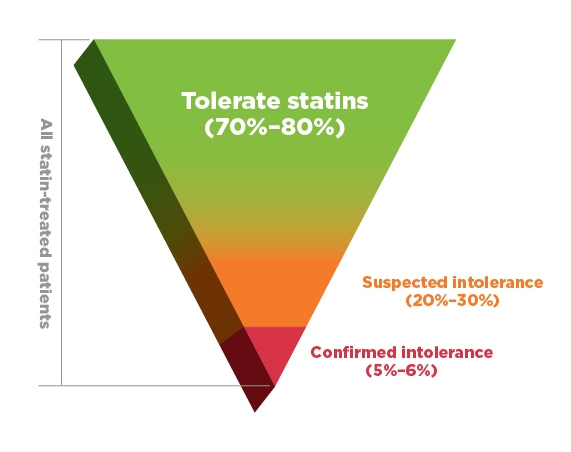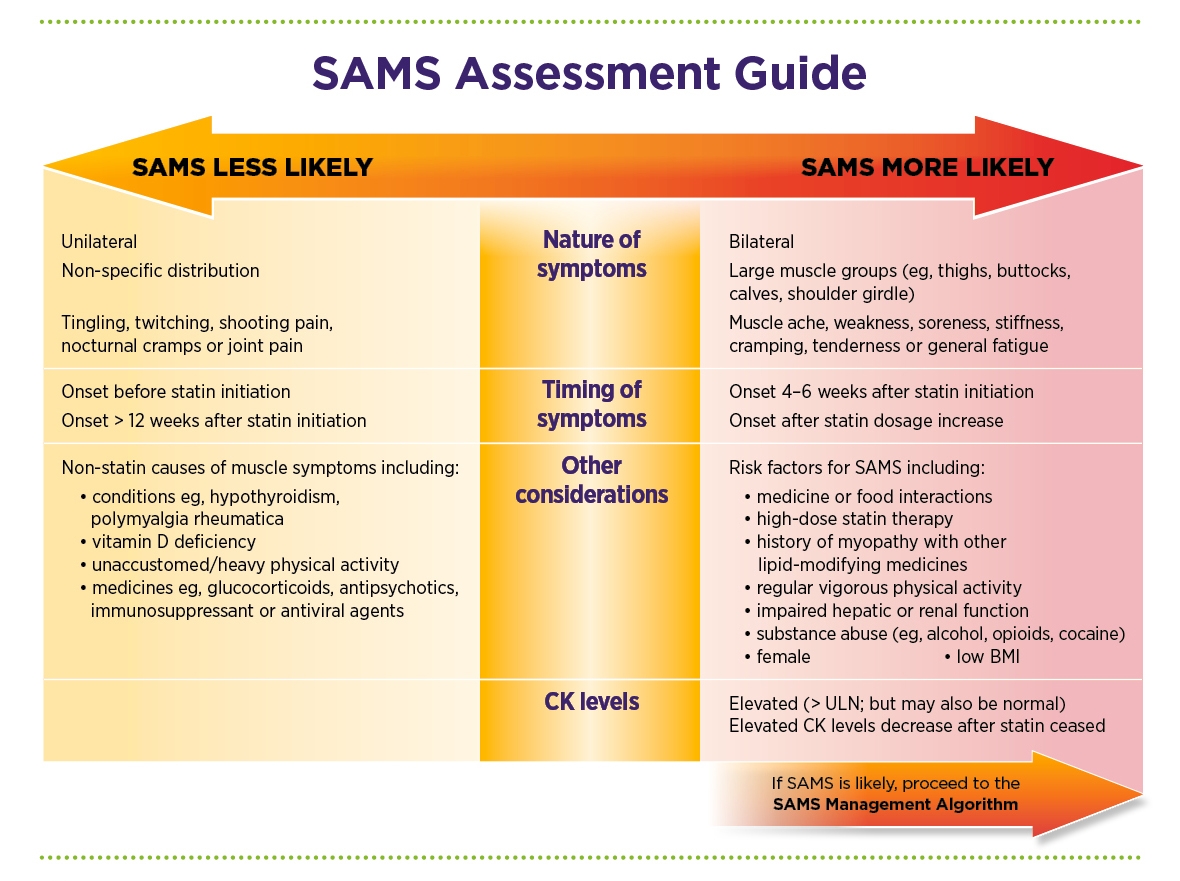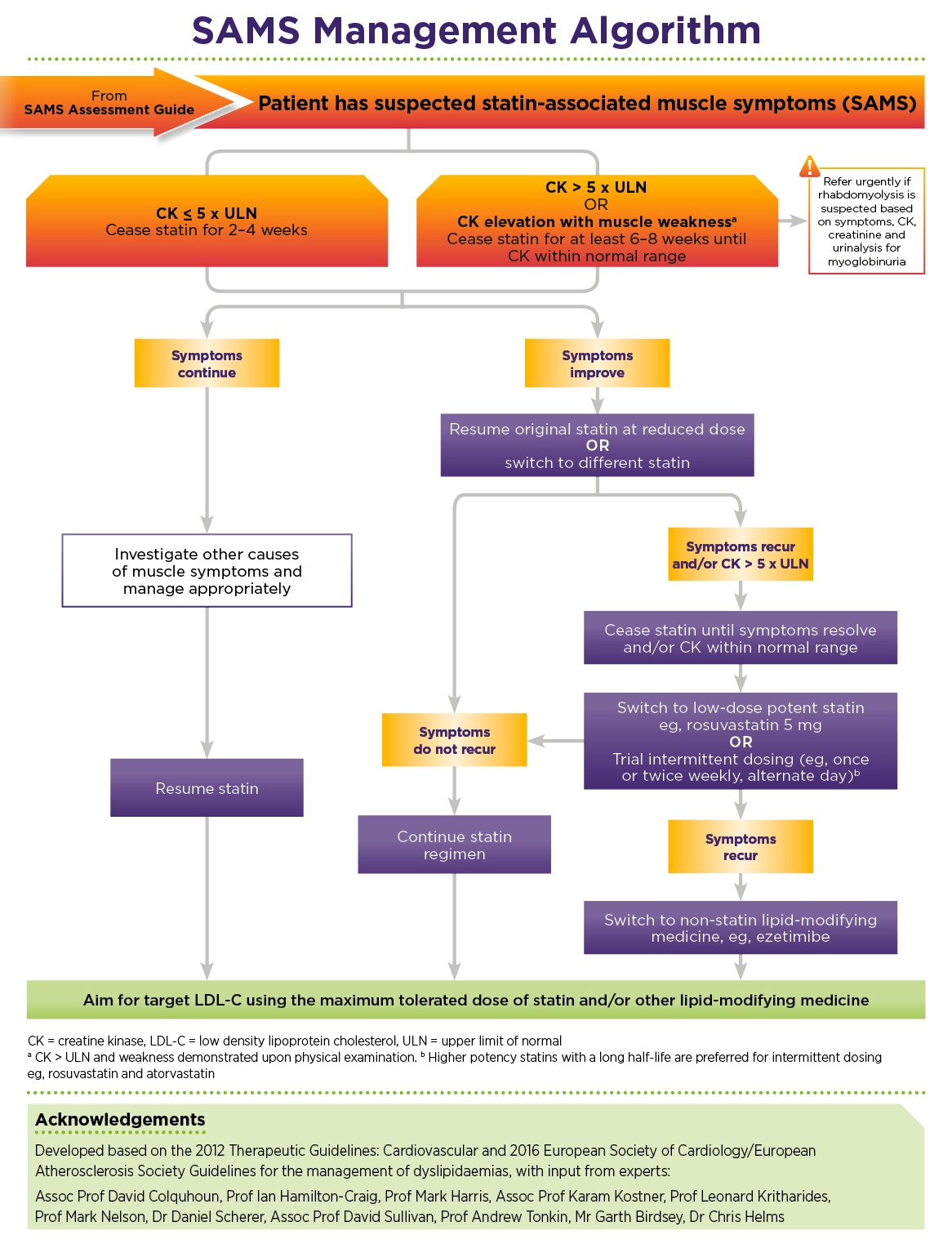Statin-associated muscle symptoms (SAMS)
Accessible web versions of NPS MedicineWise Statins clinical tools, SAMS Assessment Guide and SAMS Management Algorithm
Use a systematic approach to assess suspected statin intolerance

- Statin intolerance is rarely life-threatening and may have a lower incidence than is commonly reported.2-4
- Statins have been associated with a nocebo effect, whereby patients experience adverse effects based on the expectation of harm from a treatment.5
- For muscle-related adverse effects:
- Incidence of statin-associated myalgia is lower in blinded RCTs (1% to 5%)6 compared to observational studies (7% to 29%).4
- Myopathy incidence is ~ 1 in 10,000 per year.4
- Rhabdomyolysis incidence is ~ 1 in 100,000 per year.4
- Involve the patient in assessing and managing adverse effects.
- Advise patients to contact you if they experience muscle symptoms, and not to stop taking their statin.6
SAMS Assessment Guide

See accessible text version of this table below
| SAMS less likely | SAMS more likely | |
|---|---|---|
| Unilateral Non-specific distribution Tingling, twitching, shooting pain, nocturnal cramps or joint pain |
Nature of symptoms4,6,7 | Bilateral Large muscle groups (eg, thighs, buttocks, calves, shoulder girdle) Muscle ache, weakness, soreness, stiffness, cramping tenderness or general fatigue |
| Onset before statin initiation Onset > 12 weeks after statin initiation | Timing of symptoms4 | Onset 4-6 weeks after statin initiation Onset after statin dosage increase |
Non-statin causes of muscle symptoms including:
| Other considerations4,7 | Risk factors for SAMS including:
|
| CK levels4 | Elevated (> ULN, but may also be normal) Elevated CK levels decrease after statin ceased. |
SAMS Management Algorithm

References
- Mancini GBJ, Baker S, Bergeron J, et al. Diagnosis, Prevention, and Management of Statin Adverse Effects and Intolerance: Canadian Consensus Working Group Update (2016). Canadian Journal of Cardiology 2016;32:S35-S65. [PubMed].
- Collins R, Reith C, Emberson J, et al. Interpretation of the evidence for the efficacy and safety of statin therapy. Lancet 2016;388:2532-61. [PubMed].
- Parker BA, Capizzi JA, Grimaldi AS, et al. Effect of statins on skeletal muscle function. Circulation 2013;127:96-103. [PubMed].
- Stroes ES, Thompson PD, Corsini A, et al. Statin-associated muscle symptoms: impact on statin therapy—European Atherosclerosis Society Consensus Panel Statement on Assessment, Aetiology and Management. Eur Heart J 2015. [PubMed].
- Gupta A, Thompson D, Whitehouse A, et al. Adverse events associated with unblinded, but not with blinded, statin therapy in the Anglo-Scandinavian Cardiac Outcomes Trial—Lipid-Lowering Arm (ASCOT-LLA): a randomised double-blind placebo-controlled trial and its non-randomised non-blind extension phase. Lancet 2017. [PubMed].
- Rosenson RS, Baker SK, Jacobson TA, et al. An assessment by the Statin Muscle Safety Task Force: 2014 update. J Clin Lipidol 2014;8:S58-71. [PubMed].
- American College of Cardiology. Statin Intolerance App. 2016. [Online] (accessed 1 March 2017).
